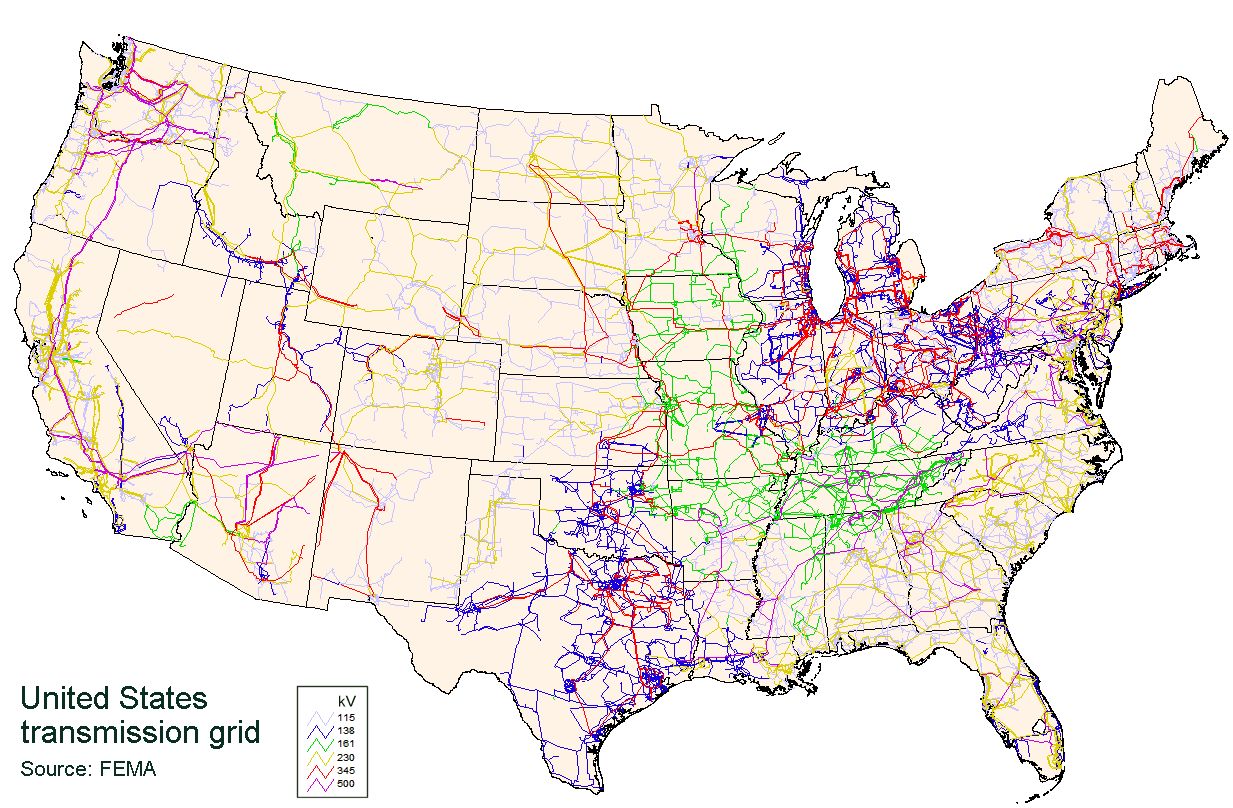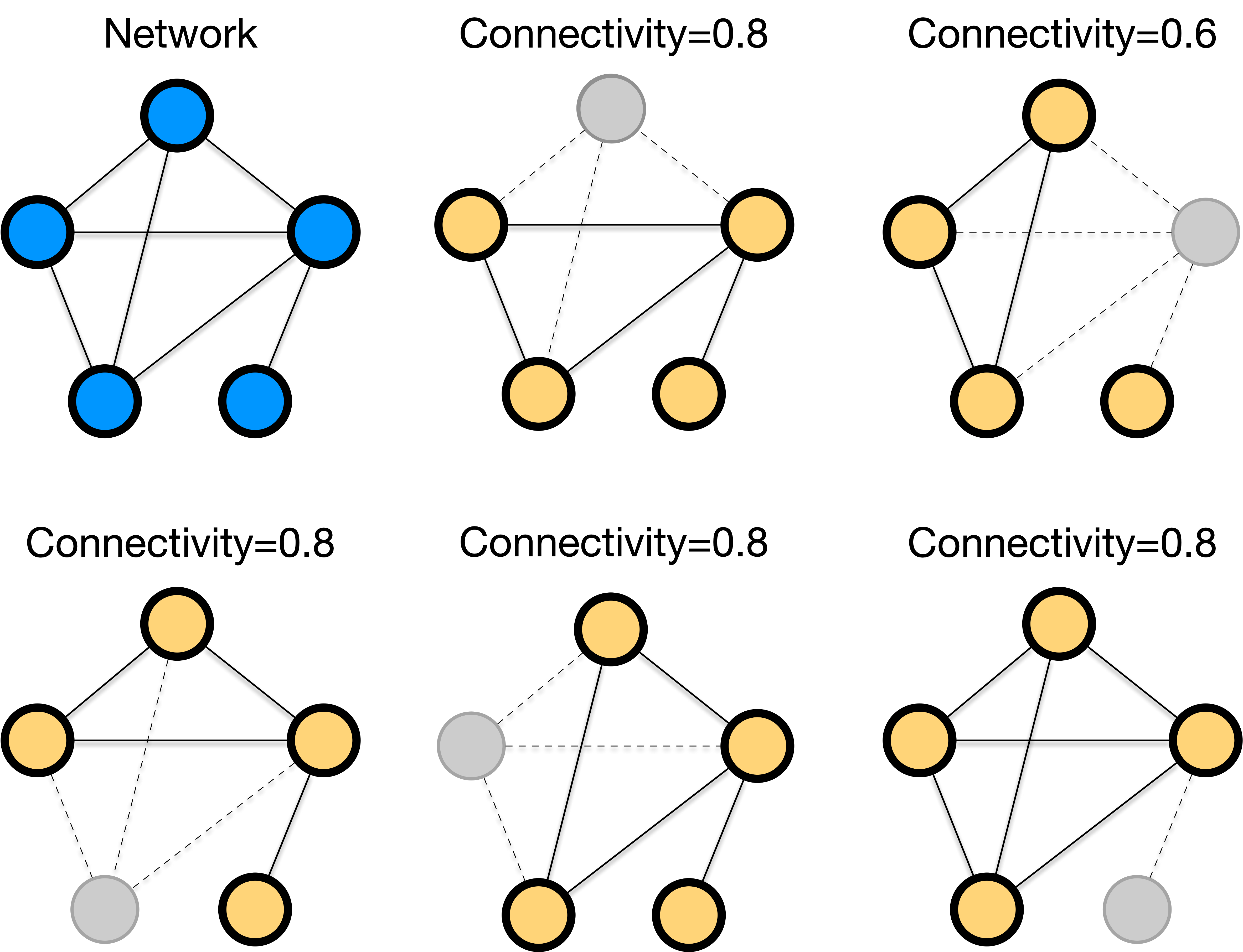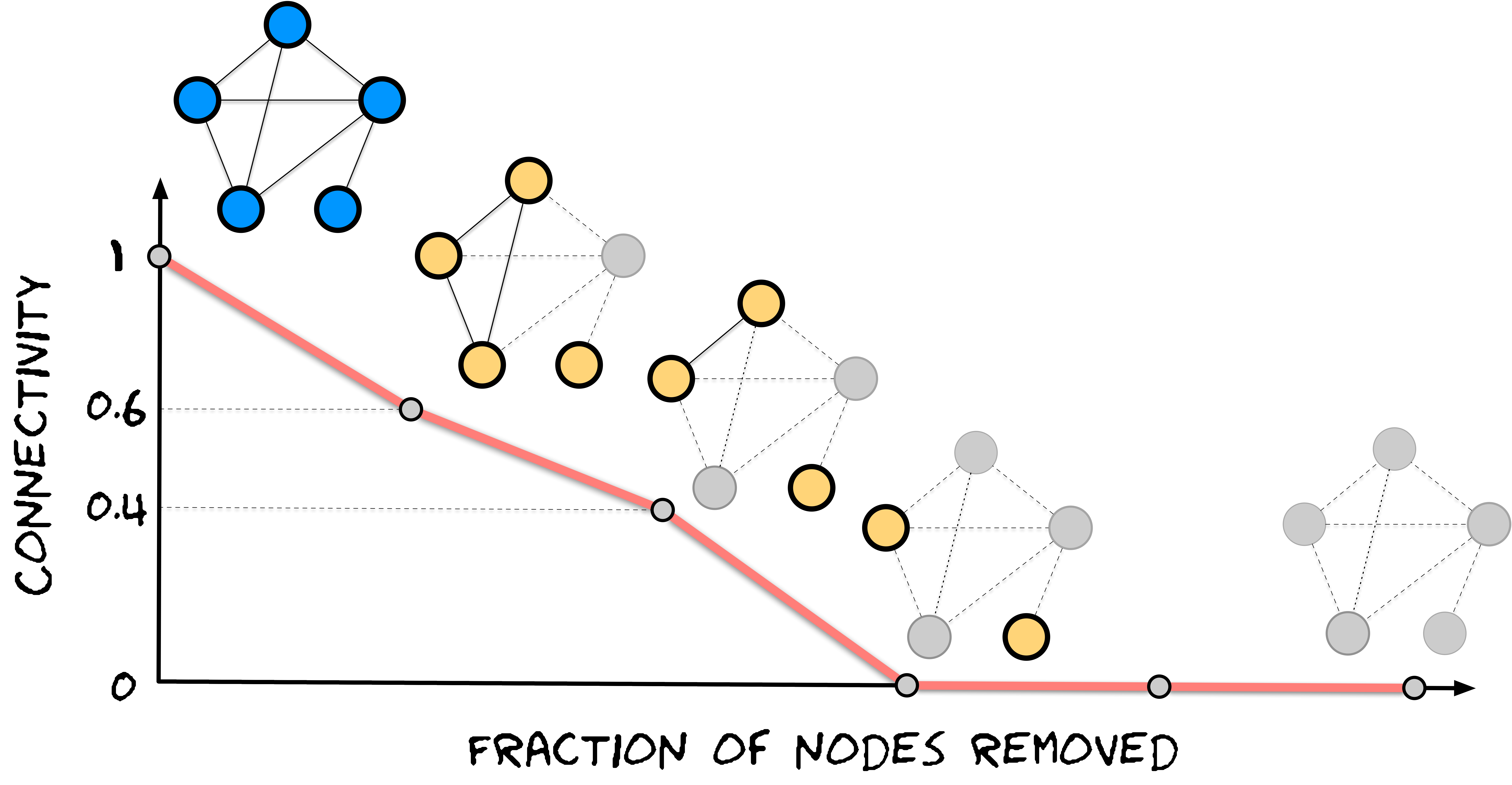Module 03: Network Robustness
Advanced Topics in Network Science
Sadamori Kojaku
skojaku@binghamton.edu

Good LLM questions for Starter Assignment:
Clustering Coefficient (3)
Global clustering coefficient focuses on the total number of triangles in the network.
\[ C = \frac{3 \times \text{number of triangles}}{\text{number of connected triplets}} = \frac{3 \times \text{number of triangles}}{\sum_{i} k_i(k_i-1)/2} \]
where \(k_i\) is the degree of node \(i\).
Connected triplets = Three nodes joined by at least two edges. When counting, we distinguish the triplets by the node that is centered. A triangle counts as three triplets. A node with degree \(k\) has \(k(k-1)/2\) triplets.
Quiz:
- Compute the global clustering coefficient and the average path length of the following network.
- Let’s define the ratio of the clustering coefficient to the average path length as the small-worldness index. What is the problem with this definition?
Learning Objectives
- MST: Minimum spanning trees and network design
- Robustness: Random failures vs. targeted attacks
- Theory: Percolation theory and connectivity
- Design: Robust networks balancing efficiency and resilience
Keywords: MST, Kruskal’s algorithm, Prim’s algorithm, percolation, R-index, robustness paradox
Part I: Minimum Spanning Tree
Post-WWI Czechoslovakia Challenge
- Connect all towns with electricity
- Limited resources for infrastructure
- Minimize cable length
- First systematic solution by Otakar Borůvka (1899-1995)

❓ Question: How would you connect all towns with the minimum total cable length?
Take 30 seconds to think about your approach…
💡 Key Insight
Key Insight: We need a tree that connects all nodes with minimum total weight.
Why a tree?
- No redundant connections (cycles)
- Every node connected exactly once
- Minimum possible edges for full connectivity
Minimum Spanning Tree (MST)
A minimum spanning tree (MST) of a weighted network is a tree that:
- Spans all nodes (connects every location)
- Is a tree (no cycles, no redundant loops)
- Has minimum total weight among all spanning trees
🤔 Algorithm Design Question
❓ Question: Given that we want the minimum spanning tree, what strategy would you use to build it?
Think about: Should we start with the cheapest connections? What if adding a cheap connection creates a loop?
💡 The Answer: Kruskal’s Algorithm
Intuition: “Choose cheapest option, avoid wasteful loops”
- Sort edges by weight (cheapest first)
- Add edges in order
- Skip if creates cycle
- Continue until all connected
Global Perspective: Considers all connections simultaneously
💡 Prim’s Algorithm
Intuition: “Organic growth from starting point”
- Start from any node (power plant)
- Find cheapest connection to an unconnected node
- Add edge, mark node as connected
- Repeat until all connected
Local Perspective: Builds incrementally from existing network
Kruskal vs. Prim
💬 Discussion: When do they find the same MST? When not?
Part II: Network Robustness
🤔 The Vulnerability Problem
What happens if a single node in our MST fails?
Think about: How many towns would lose power? What does this mean for real infrastructure?
Cost efficiency ≠ Robustness
💬 Discussion: How would you modify the network to make it more robust? What are the trade-offs between cost and reliability?
Measuring Network Connectivity
\[\text{Connectivity} = \frac{\text{Size of largest component after removal}}{\text{Original network size}}\]

Robustness Profile: Connectivity vs. fraction of nodes removed

R-index: Area under robustness curve \[R = \frac{1}{N} \sum_{k=1}^{N-1} y_k\]
🤔 Attack Strategies
Random Failures:
- Unpredictable events
- Earthquakes, equipment malfunctions
- Technical problems, random server crashes
- Characterized by equal probability of failure for all nodes
Targeted Attacks:
- Strategic node removal by adversaries
- Target busiest airports to disrupt air travel
- Characterized by removing highest-degree nodes, then next highest
Game Time!
Think about a structure that is robust to random failures/targeted attacks/both
Why might the same network structure respond so differently to these two scenarios? What does this tell us about network design?
Part III: Theoretical Framework
Percolation Theory
- Suppose puddles are scattered on the ground.
- As rain falls, puddles begin to merge with nearby puddles.
- At first, most puddles are isolated; as more rain falls, clusters form, and eventually a giant puddle spans a large part of the area.

Percolation theory studies how local connections (like merging puddles) lead to sudden global connectivity.
Phase Transition
Critical Point (\(p_c\)): Threshold where giant component emerges/disappears
2D Lattice Example: \(p_c \approx 0.593\)
Lecture notes for demonstration
The sharp transition around \(p_c\) demonstrates a phase transition, i.e., a sudden change from a disconnected to connected state as we cross the critical threshold.
Network Robustness - Where is the critical point?
🤔 Let’s Think Like Network Scientists
Let’s learn how to find the critical point \(p_c \approx 0.593\)
Imagine you’re a node in a network. For you to be a part of the largest connected component, what do you & your friends need 🤔?
- You need friends (connections)
- What else do your friends need?

🔗 Friends of Friends
- Each friend needs at least 2 connections
- One connection: to you
- Another connection: to someone else (to reach the rest of the network)

Your friends need at least 2 friends (on average) for you to be a part of the giant component!
\[ \text{Average \# of friends that friends have} \geq 2 \]
Let’s formalize this insight.
\[ \text{Average \# of friends that friends have} \geq 2 \]
- Suppose you are node 1 with one hand
- Other nodes have \(k\) hands with probability \(p(k)\)
- When you handshake with a randomly picked hand (not node), how many hands do your friends would have on average 🤔?
Suppose \(p(k)\) is the fraction of nodes with \(k\) hands. Altogether, nodes with \(k\) hands contribute \(k p(k)\) hands to the network.
If I randomly pick a hand, I would handshake with a node with \(k\) hands with probability proportional to \(k p(k)\). That is
\[ q(k) = \frac{k p(k)}{\sum_{k=1}^{\infty} k p(k)} = \frac{k}{\langle k \rangle } p(k), \]
where \(\langle k \rangle = \sum_{k=1}^{\infty} k p(k)\) is the average degree. Now, the average number of hands that my friends would have on average is
\[ \langle k \rangle_{q(k)} = \sum_{k=1}^{\infty} k q(k) = \sum_{k=1}^{\infty} k^2 / \langle k \rangle p(k) = \frac{\langle k^2 \rangle}{\langle k \rangle}. \]
🎯 The Molloy-Reed Criterion
You just discovered the Molloy-Reed Criterion! \[\kappa = \frac{\langle k^2 \rangle}{\langle k \rangle} > 2\]
When is the \(\kappa\) smallest 🤔? What is the implication in terms of the robust network structure against random failures?
Take 2 mins to think about it…
- High κ: Hub-dominated networks (some nodes have many friends)
- Low κ: Degree homogeneous networks (everyone has similar friends)
- Implication: Hubs make networks more robust!
🧮 From κ to Critical Fraction
Now let’s figure out: What fraction of nodes can we remove before the network fragments?
Hint: After removing a fraction \(f\) of nodes randomly, what happens to the number of friends a friend would have?
And when does the Molloy-Reed criterion break?
Take 3 mins to think about it.
- After removing fraction \(f\), my friend who initially has—\(\kappa\) friends on average—have \((1-f)(\kappa -1)\) friends on average.
- It’s \(\kappa-1\) not \(\kappa\) because one of the friends is me.
- Thus, the network breaks when \((1-f)(\kappa - 1) = 1\)
- Solving for \(f\), we get \[f_c = 1 - \frac{1}{\kappa - 1}\]
🤔 Case Study: Degree-Homogeneous Networks
Let’s consider a degree-homogeneous network, where the degree distribution is Poisson with mean \(\lambda\), i.e.,
\[ k \sim \mathrm{Poisson}(\lambda) \]
What is the critical point \(f_c\)?
Hint:
- \(f_c = 1 - \frac{1}{\kappa - 1}\), \(\kappa = \frac{\langle k^2 \rangle}{\langle k \rangle}\)
- The mean and variance of the Poisson distribution are identical.
For a Poisson distribution with mean \(\lambda\):
- The first moment (mean degree) is \(\langle k \rangle = \lambda\)
- The second moment is \(\langle k^2 \rangle = \lambda^2 + \lambda\)
Now, we can calculate \(\kappa\):
\[ \kappa = \frac{\langle k^2 \rangle}{\langle k \rangle} = \frac{\lambda^2 + \lambda}{\lambda} = \lambda + 1 \]
Finally, we can find the critical fraction \(f_c\): \[ f_c = 1 - \frac{1}{\kappa - 1} = 1 - \frac{1}{(\lambda + 1) - 1} = 1 - \frac{1}{\lambda} \]
Key Insight: Higher average degree makes the network more robust.
🤔 Case Study: Degree-heterogenous networks
❓ Question: What happens to network robustness when we have a few very highly connected nodes (hubs) and many poorly connected nodes?
Think about: How would random failures affect this type of network? What about targeted attacks?

💡 Robustness of scale-free networks
Let’s consider a scale-free network with the degree distribution:
\[P(k) \sim k^{-\gamma}\]
Infinite variance for \(\gamma < 3\), undefined mean for \(\gamma \leq 2\).
Most real-world networks do not have finite variance!
What does it mean in terms of the robustness of the network?

When the network is infinite,
\(f_c \rightarrow 1\) when \(2 < \gamma < 3\).
When the network is finite,
\[f_c = \begin{cases} 1 - \dfrac{1}{\frac{\gamma-2}{3-\gamma} k_{\text{min}} ^{\gamma-2} k_{\text{max}}^{3-\gamma} -1} & \text{if } 2 < \gamma < 3 \\ 1 - \dfrac{1}{\frac{\gamma-2}{\gamma-3} k_{\text{min}} - 1} & \text{if } \gamma > 3 \\ \end{cases}\] $ where \(k_{\text{min}}\) and \(k_{\text{max}}\) are the minimum and maximum degree. (Visualization)

Key Insight: Scale-free networks are remarkably robust to random failures.
🤔 Questions
- ❓ Question #1: If scale-free networks are so robust to random failures, what’s their weakness?
- Scale-free networks are fragile under targeted attacks.
- ❓ Question #2: What type of attack is the most effective and why?
- Removing the highest degree node and then the second highest degree node, and so on, is the most effective.
- …because the critical fraction depends on \(k_{\text{max}}\).
Critical point \(f_c\) for targeted attacks
A node removal changes the degree distribution from \(P(k)\) to \(P'(k)\). Specifically,
- A node with degree \(k\) is removed from \(P(k)\), and
- its neighbors lose 1 degree.
We ask: when does \(P'(k)\) lose the giant component as nodes are removed? This gives:
\[f_c^{\frac{2-\gamma}{1-\gamma}} = \frac{2 + 2^{-\gamma}}{3-\gamma} k_{\min} \left(f_c^{\frac{3-\gamma}{1-\gamma}} - 1\right)\]
\(f_c\) increases as \(\gamma\) increases, which is in contrast to the random failures case.
\(f_c\) for the random and targeted attacks converge to the same value as \(\gamma \rightarrow \infty\).
\[f_c^{\frac{2-\gamma}{1-\gamma}} = \frac{2 + 2^{-\gamma}}{3-\gamma} k_{\min} \left(f_c^{\frac{3-\gamma}{1-\gamma}} - 1\right)\]

🤔 Design Challenge
❓ Question: Given what we’ve learned about network vulnerabilities, how would you design a robust network?
Consider: What principles would you use? How would you balance cost, efficiency, and security?
Create a network with Interactive game
Let’s code!
List of all nodes
Remove a node
Component size
components = g.connected_components()
components.sizes() # Sizes of all components
np.max(components.sizes()) # Size of the largest componentMisc: